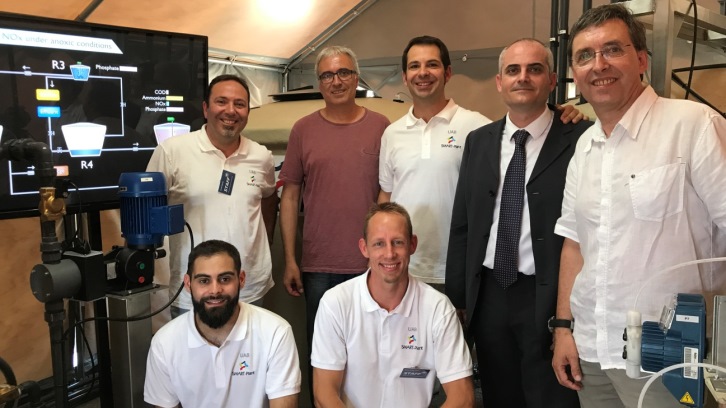Presentation of a new wastewater treatment technology, towards circular economy and resource recovery

The Universitat Autònoma de Barcelona, in collaboration with the municipal water company Aigües de Manresa S.A., presented a study conducted within the framework of the European SMART-Plant project for the development of a new technology: Mainstream SCEPPHAR. This new technology will bring the water sector closer towards the achievement of what is known as a "circular economy of water". The main objective is to improve current Wastewater Treatment Plants (WWTP) and even go further in the search for an increase in energy efficiency, in reducing the emission of greenhouse gases, and in the recovery of useful resources such as biopolymers, cellulose or biogas.
The water sector has recently changed the paradigm from just treating wastewater to also considering resource recovery. Hence, wastewater treatment plants (WWTPs) are nowadays known as Water Resource Recovery Facilities (WRRFs). WWTPs usually remove organic matter and nutrients (phosphorus and nitrogen), but WRRFs should go one-step further and should aim at recovering energy (such as biogas, methane or hydrogen), water and material resources (such as fertilisers, bioplastics or cellulose).
This work shows a new technology developed, which is called "Mainstream SCEPPHAR (Short-Cut Enhanced Phosphorus and Poly-Hydroxy-Alkanoate Recovery)", and drives the water sector towards the circular economy scenario. It has been part of the European SMART-Plant project (Scale-up of low-carbon footprint Material Recovery Techniques, EU-H2020, grant agreement 690323, EU-H2020-WATER-1b-2015, www.smart-plant.eu, https://www.youtube.com/watch?v=8sSTxh6p--0) with a duration of 4 years, an investment of 9,768,806.09 euros and 26 partners (companies and universities) from 10 EU countries. The overall objective of the project has been to scale up and demonstrate eco-innovative solutions to upgrade existing WWTPs in a real-world environment. During the project, up to nine pilot plants have been tested with the aim of improving wastewater treatment, energy efficiency, greenhouse gas reduction and resource recovery. In addition, the recovered resources (biopolymers, cellulose, fertilizers and intermediate products) have been processed into marketable products.
The Mainstream SCEPPHAR system developed by the UAB and Aigües de Manresa S.A., a municipal company, increases urban wastewater treatment efficiency while extracting fertilizers and precursors of bioplastics. This work presents the long-term operation of a demo-scale SCHEPPHAR pilot plant treating real wastewater from a municipal WWTP (Manresa-Sant Joan de Vilatorrada) under relevant environmental conditions, being the first demo-scale implementation of this technology. The SCEPPHAR configuration is based on two sequential batch reactors (SBR): the R1-HET performs biological phosphorus/nitrogen removal and PHA accumulation, while R2-AUT is in charge of ammonium oxidation to nitrite or nitrate. An additional precipitator is used for struvite production.
Detailed diagram of the Mainstream SCEPPHAR process.
The SCEPPHAR pilot plant operated for a long period of 450 days with successful results in terms of C, N, and P removal efficiency. Regarding P recovery, 45-63% of the P in the influent could be recovered as struvite, a slow release fertiliser. This value is much higher than the typical values reported, around 12%, achieved in previous developments. Concerning the production of bioplastic precursors, mainstream SCEPPHAR reached a biomass of up to 9% PHA, a higher value than those typically found in sludge. This biomass can be used to enhance energy production as biogas.
The economic feasibility study shows that the SCEPPHAR technology would nowadays require a water tariff 15% higher than that of a conventional WWTP. Therefore, incentives to encourage resource recovery would need to be legislated to make it economically viable, but further optimization of the operation is still feasible.
Department of Chemical, Biological and Environmental Engineering, GENOCOV.
School of Engineering,Universitat Autònoma de Barcelona.
References
Larriba, O., Rovira-cal, E., Juznic-zonta, Z., Guisasola, A., Baeza, J.A., 2020. Evaluation of the integration of P recovery, polyhydroxyalkanoate production and short cut nitrogen removal in a mainstream wastewater treatment process. Water Res. 172, 115474. https://doi.org/10.1016/j.watres.2020.115474


